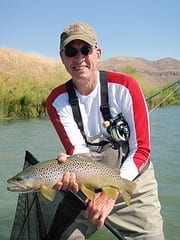James Stoller
Cleveland, Ohio, United States
 |
|
Photo by Jeff Smith |
I am one of the many doctors who relish the zen of flyfishing. Standing in a stream, reading the clues for what type of fly to cast and where to cast it, and focusing incessantly on a dry fly drifting lithely to entice a hungry trout, flyfishing invites self-reflection through the cadence of the flowing stream and the rhythm of the cast.
There may be several reasons that draw doctors to flyfishing. As in the practice of medicine, flyfishing combines cognitive and technical challenges and requires prowess in both to be successful. The seasoned angler is taking in and synthesizing environmental data in order to generate a hypothesis. Do I hear grasshoppers, such that a hopper pattern cast near shore is the plan? Do I see fish rising, such that a dry fly would be better? With a dichotomous outcome—the fish either takes the fly or does not—the hypothesis is that if I choose a particular fly, cast to a specific place with a precise presentation, then the fish will take the fly. If . . . , then . . . , just like practicing medicine. Even if my hypothesis is correct, whether I actually catch the fish, of course, depends on a delicate mixture of serendipity and skill, much like the patient’s outcome in being cared for by a skilled clinician. In the parlance of flyfishing, the fish may take my fly if I cast a parachute adams at the tailout of the riffle. Here is another commonality between flyfishing and medicine: both have jargon that is shared by colleagues, economizes communication among them, and may elicit quizzical reactions from others who may regard the language as quirky and strange. What is a parachute adams? What is the bronchus intermedius?
Like many specialties in clinical medicine, flyfishing also requires technical prowess. The act of casting is about understanding the physics of loading the rod in order to store and then release kinetic energy, which propels the fly line forward even though the fly itself is virtually weightless. As another dimension of fly angling, tying flies is an exacting craft—assembling tiny amounts of material on the shank of a hook to simulate the appearance of a bug or baitfish. Building fly rods is yet another art form. So too is the practice of medicine.
Flyfishing is similar to the process of scientific inquiry. Indeed, the act of casting to a fish can be likened to a clinical trial; the results of clinical trials are the bedrock of evidence-based clinical practice and the cast is the central element of flyfishing. The clinical trial, like the approach to the fish, starts with a hypothesis—which fly, cast where, and how? Successfully conducting a clinical trial requires precise administration of the study intervention—the medication must be administered in the correct dose; the surgery must be carefully performed; or the device must be skillfully placed. The cast must also effectively present the fly in the right way, place, and moment in order to produce the desired outcome. Furthermore, as with clinical trials, the outcomes in flyfishing are clear and dichotomous. The fish is caught or not. Except for the occasional confabulatory fish tale that is told among denizens of fishing lodges, whether the fish was caught or not is generally not subject to debate. Quantitative metrics apply. How many fish were caught and how big was the largest? Other than the hyperbolic proclivities of some anglers (and, I suppose, some doctors who regrettably commit scientific misconduct), size and number are objective truths.
Still, in discussing the outcomes of flyfishing, most seasoned anglers would quibble with the idea that the outcome is dichotomous, and is merely about whether the fish was caught or not. The real point, they would say (and I would heartily agree), is being there. Flyfishing is a surrogate endpoint, an excuse to be in a beautiful place, highly mindful of one’s surroundings, and focused on a tiny fly in pursuit of a fish, the whole activity making the issues of the world—and one’s own—melt away. The goals of medicine are also not summed up solely by dichotomous outcomes or quantitative metrics. The real point of being a great doctor is being fully present for the patient.
An executive coach once pointed out to me that doctors seek two things as drivers of their careers: mastery and impact. We want to be really good at what we do and we want that mastery to benefit people’s lives. So too with flyfishing. It takes many years of study and deliberate practice to become a really good doctor; and it takes lots of time on the water to become a great fly angler. One could say that mastery in both is actually elusive—we never fully achieve it, but we continuously and incessantly seek it.
It would seem that the popularity of flyfishing among doctors is not at all coincidental. It is the predictable consequence of a deep commonality that both medicine and flyfishing share—a passion for challenge, the quest for clear success in our efforts, an appetite to continuously get better at a challenging undertaking through deliberate practice, and the hope to make a difference through excellence.
JAMES K. STOLLER is a pulmonary/critical care physician at the Cleveland Clinic. He holds the Jean Wall Bennett Professorship and the Samson Global Leadership Academy Endowed Chair at the Cleveland Clinic Lerner College of Medicine and serves as the Chairman of the Cleveland Clinic Education Institute. Dr. Stoller holds a Masters degree in organizational development and serves as adjunct Professor of Organizational Behavior at the Weatherhead School of Management of Case Western Reserve University.
Winter 2019 | Sections | Doctors, Patients, & Diseases

Leave a Reply